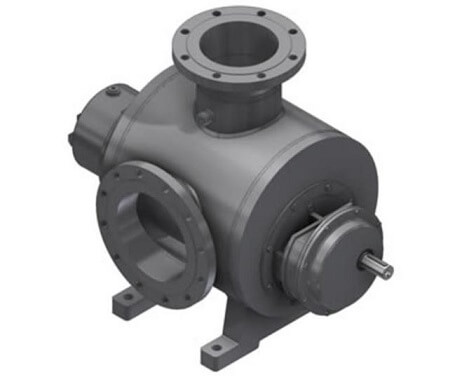Screw Pump Troubleshooting Guide
 A screw pump when working correctly operates quietly, with little vibration or pulsation. If you are starting to notice issues such as a reduction of flow rate, pressure, increased vibration, or leakage an inspection is necessary. Pumps should be inspected according to their hours of operation and ideally every 6 months. A pump cannot be considered as a standalone item and must be considered as part of system. This means troubleshooting can take some time involving checking system components, control panel settings and potentially a full strip down of the pump.
A screw pump when working correctly operates quietly, with little vibration or pulsation. If you are starting to notice issues such as a reduction of flow rate, pressure, increased vibration, or leakage an inspection is necessary. Pumps should be inspected according to their hours of operation and ideally every 6 months. A pump cannot be considered as a standalone item and must be considered as part of system. This means troubleshooting can take some time involving checking system components, control panel settings and potentially a full strip down of the pump.
If you are experiencing issues with your Screw Pump, and don’t know where to start the below guide can help you diagnose any issues. Alternatively speak to one of our Technical Sales Engineers for further assistance:
 (1)-24071514211309875-24071514215280972-24071514215974141-24071514220241868.png)
Screw Pump Troubleshooting Guide
Problem | Possible Cause | Remedy |
Low Capacity or loss of flow | System restriction | Check system including all vales on suction and discharge. Check fluid levels in tank, and that any non-return valves are functioning as intended |
Pump Priming | Ensure all air has been vented from pump and that | |
Low Pump Speed | Check motor speed, and ensure motor is not overloaded. If belt driven ensure belt is taught, without slippage. If operated via VFD ensure pump is operating at correct speed on panel. | |
Reverse Rotation | Check motor direction of rotation is in line with arrow on nameplate and motor | |
Blockage | Check suction and discharge pipes. Remove blockage | |
Screws Worn | Replace screws. Ensure idler and driving screws are replaced as set and not individually | |
Liquid Change | Check viscosity of fluid is as per pump design. Check if fuel has been switched to one of low lubricity such as Low Sulphur Fuel Oil (LSFO) | |
Bypass Valve Operation | Check bypass valve operating pressure, check spring and maintenance history as may require replacing | |
NPSH not met | Insufficient suction pressure. Reduce pump speed, increase level in suction tank, check fluid viscosity, check temperature of fluid is not close to vapor pressure, deepen suction pipe. | |
Loss of Suction | System Blockage | Check suction pipework for blockage, check valves are operational in both suction and discharge. |
Air Ingress | Check pipework connections for wear and air ingress. | |
Viscosity too High | Check viscosity is in line with pump design. Increase motor size, increase pump size, heat fluid, reduce pump speed. | |
Suction Strainer Blocked | Check inlet filter and clean or replace | |
Reverse Rotation
| Check motor direction of rotation is in line with arrow on nameplate and motor | |
Low Discharge Pressure | NPSH not met
| Insufficient suction pressure. Reduce pump speed, increase level in suction tank, check fluid viscosity, check temperature of fluid is not close to vapor pressure, deepen suction pipe.
|
Air Ingress
| Check pipework connections for wear and air ingress | |
Screws Worn
| Replace screws. Ensure idler and driving screws are replaced as set and not individually
| |
System Blockage
| Check suction pipework for blockage, check valves are operational in both suction and discharge.
| |
Suction Strainer Blocked
| Check inlet filter and clean or replace
| |
Bypass Valve Operation
| Check bypass valve operating pressure, check spring and maintenance history as may require replacing
| |
Noise or Vibration | Misalignment | Check coupling alignment |
Pump loose on base plate | Check pump fixings | |
System Blockage
| Check suction pipework for blockage, check valves are operational in both suction and discharge.
| |
Air Ingress
| Check pipework connections for wear and air ingress | |
Suction Strainer Blocked
| Check inlet filter and clean or replace | |
Relief Valve | Relief valve is opening and closing rapidly. Check relief valve set pressure and increase | |
Pump parts contact | Check pump bearings, shaft wear, casing condition and seal. Replace as required | |
Solid ingress | Check screws for solid ingress or particles located within pump above specified size | |
Excessive Pump Wear | Fluid | Check fluid for particles, check inlet filter, check history of fluid, if LSFO check for low lubricity. |
Water | Some Screw pumps are not designed for water or glycols of specific concentrations. Speak with a technical sales engineer to check pump selection and chemical compatibility | |
Misalignment
| Check coupling alignment
| |
NPSH not met
| Insufficient suction pressure. Reduce pump speed, increase level in suction tank, check fluid viscosity, check temperature of fluid is not close to vapor pressure, deepen suction pipe. | |
High Absorbed Power | Fluid Viscosity | Check viscosity is in line with pump design. Increase motor size, increase pump size, heat fluid, reduce pump speed. |
Suction Strainer Blocked
| Check inlet filter and clean or replace | |
Pump parts contact
| Check pump bearings, shaft wear, casing condition and seal. Replace as required | |
Pump Speed | Check pump speed is in line with design | |
Air Ingress
| Check pipework connections for wear and air ingress |





